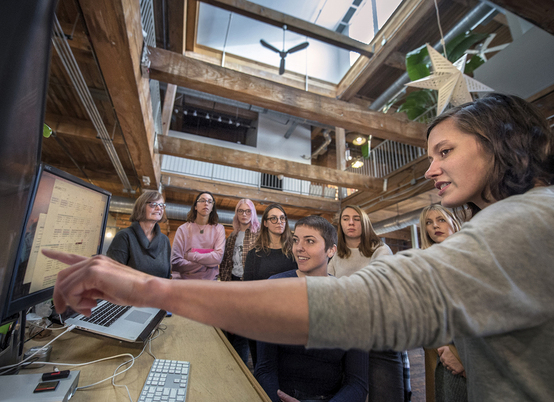
News . Feature Stories . Studio position equals career that isn't 'work'
News
May 21, 2018
Studio position equals career that isn't 'work'
Photo grad Hileman works at Kalman & Pabst

Hileman talks to CIA photo majors during a tour of Kalman & Pabst
By Betsy O’Connell
If someone had asked Rosie Hileman 10 years ago if she could picture herself as a commercial photographer, the answer would have been definitely not.
“I didn’t understand what it was,’’ says Hileman ’12 as she showed a visitor around where she works as a photographer at Kalman & Pabst Photo Group in Cleveland’s Midtown neighborhood. “People say ‘commercial’ and they think everything personal is taken out of it. That’s not true. I wouldn’t do this if I didn’t have any say.’’
Clients have high expectations, which can amp up the stress, but the positive outweighs the long hours and demands of her job, Hileman says.
“I basically never go to work, it feels like. I am doing what I love all day.’’
Hileman started her studies at the Cleveland Institute of Art with the intention of majoring in painting. But her paintings weren’t as realistic as she wanted them to be, so she moved to photography.
Hileman did freelance work for three years. She was never sure of what she would be making or what her schedule would look like. And there was “the constant hustle,” she says. “Networking, creating, showing your work. You are always 'on.' I'm an introvert, so it was a very hard thing to do.’’
She did photo assistant work for Kalman & Pabst and was hired full-time more than two years ago. Now she is one of three photographers for the company, whose clients include Smucker’s, Kitchen Aid, Arhaus, Libbey, and Red Lobster.
Making photographs is just part of her job. Before the camera work comes designing and building sets, determining lighting, and choosing props. “You definitely have to
be comfortable with power tools,’’ she says.
Food photography today has changed from years past, she says. The food itself is more natural; soft lighting and a few burned crumbs are all acceptable.
On a computer, she flips through several of her most recent jobs, including a series of about 10 options for what became a single image for Libbey glassware. Each photo focuses on a specific aspect of a glass of beer—how the beer is pouring out of the bottle, the rim of the glass, the bubbles in the beer.
The final result is a single shot that combines the best part of each of the shots.
The studio fosters collaboration, Hileman says. “We all stop what we are doing in the middle of the day to eat together.’’ Her personal photography tends to be still life, often around food. She likes working with shape, color and texture.
“For me it’s about creating a photograph, not just taking it.’’
Latest Headlines view all
-
April 24, 2024
Cleveland Institute of Art welcomes alum Omari Souza as 2024 Commencement speaker -
April 02, 2024
Cleveland Institute of Art students partner with Progressive Art Collection to exhibit Ready, Set, Relay! -
March 04, 2024
Cleveland Institute of Art announces Curlee Raven Holton Inclusion Scholar Program
Questions?
For more information about this or other CIA news, contact us here.
Social Feed